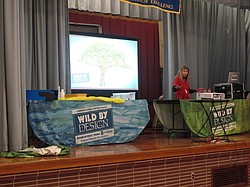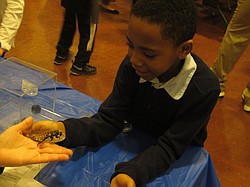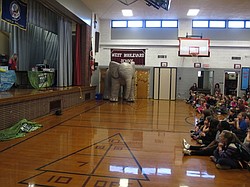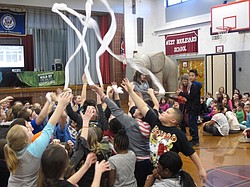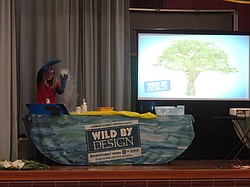Neighbors | Zack Shively.West Boulevard Elementary invited Beth Colbert from the Carnegie Science Center to the school to give a presentation. The assembly, named "Wild by Design," is a part of the center's Science on the Road program.
Neighbors | Zack Shively.Along with the "Wild By Design" presentation, the Carnegie Science Center brought several activity stations for the students to have a hands-on experience with the concepts taught during the presentation. Pictured, one of the stations had a beetle, which had been talked about during the assembly.
Neighbors | Zack Shively.Carnegie Science Center's "Wild by Design" presentation focused on biomimetics, or the way scientists look to nature for innovation, such as birds wings for the early airplanes.
Neighbors | Zack Shively.Beth Colbert of the Carnegie Science Center had some exciting demonstrations to describe scientific concepts. Pictured, she used a leaf blower and toilet paper to explain lift.
Neighbors | Zack Shively.The PTA of West Boulevard Elementary contacted and brought the Carnegie Science Center's assembly presentation to the school. Pictured, Beth Colbert demonstrated the uses of liquid nitrogen, such as utilizing it to create pressure and shoot bottles in the air.
By ZACK SHIVELY
The Carnegie Science Center visited West Boulevard Elementary on Feb. 27 to teach the students about biomimetics.
The school’s PTA invited Beth Colbert from the Science Center to give a “Science on the Road“ presentation to the students in the gymnasium twice during the day. Along with the presentation, the PTA ran “adventure work stations” in the auditorium that gave students a more hands-on experience. These stations were also a part of Carnegie Science’s set up.
Colbert explained biomimetics as “science based on nature.” The presentation, titled “Wild By Design,” demonstrated the different forms of technology that have been invented by looking at nature and wildlife as inspiration.
She began her presentation with a history of the Wright brothers. The two brothers looked to birds when creating their planes, unlike their contemporaries. They had their success because they used nature as a reference point.
Colbert had a number of demonstrations to exhibit some science concepts. She had two volunteers hold a roll of toilet paper while she used a leaf blower to push the paper in the air and off the roll. This demonstration taught the students about lift.
Lynda Beichner, the president of the school’s PTA, said she believed that the event served as a good STEM lesson for the children. She explained that the school has had a history of inviting the center’s program to the school.
The adventure stations derived from the presentation. They had several stations that reinforced what the students learned. One of the stations demonstrated how a turtle and submarine choose to submerge and float. They also had some of the animals from the presentation, such as beetles, at the stations.
Carnegie Science Center’s program does several different shows each year. Most of their presentations are for students from kindergarten to sixth grade. Along with the assembly presentations, the center has a mobile planetarium that it brings to events.
Colbert began working with the science center in 2006. She had always had an interest in science and studied archeology. She eventually applied to the program and has worked for the center since.
 43
43

